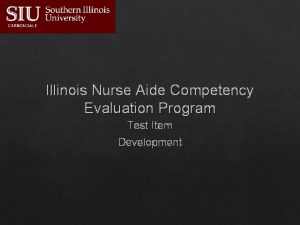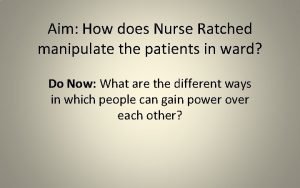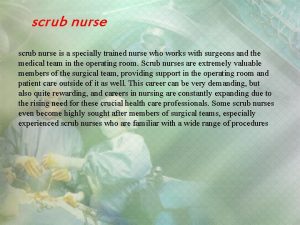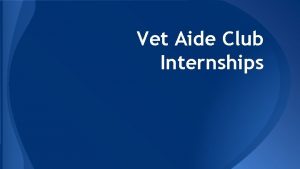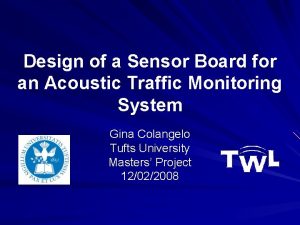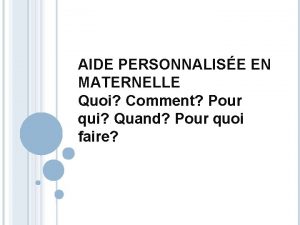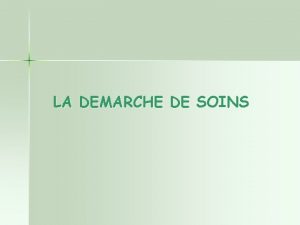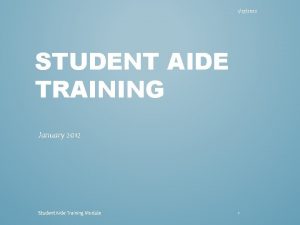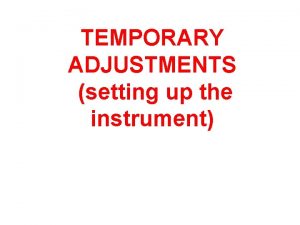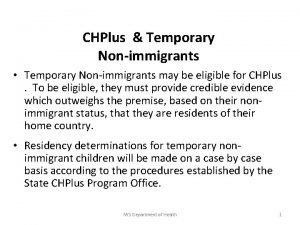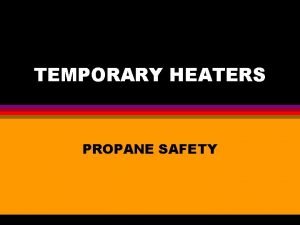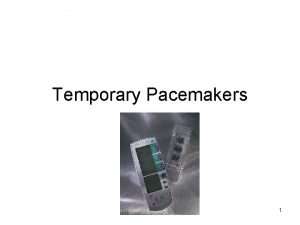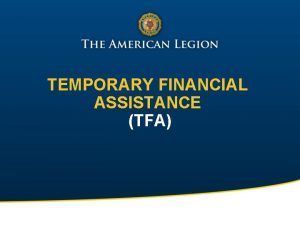for Patients in Isolation A TEMPORARY NURSE AIDE















- Slides: 15

for Patients in Isolation A TEMPORARY NURSE AIDE GUIDE

Help patients with basic living activities Temporary Nurse Aide Primary Duties Listen to health concerns of patients Measure vital signs Housekeeping Tending to patient issues and problems

What a Temporary Nurse Aide Can Do A Temporary Nurse Aide can work under the supervision of a registered or enrolled nurse to help provide basic nursing care such as showering, hair, skin and mouth care. They can assist with activities essential for daily living including helping people with dressing and feeding. They may also perform simple wound dressings, transport stable patients or residents between beds or wards, and undertake nursing observations such as pulse, temperature and respiratory rates.

Caring for Patients in Isolation Monitor symptoms Prevent the spread of the virus Treat symptoms Decide when to end isolation

Visits for COVID-19 Positive Patients In the U. S. , federal government guidelines recommend halting all visits except during end of life and other extraordinary situations, when visitors should be equipped with personal protective gear. The federal agency that regulates nursing homes urges them to designate separate facilities to keep COVID 19 residents away from those who have tested negative.

Environmental Cleaning and Disinfection Routine cleaning and disinfection procedures are appropriate for SARS Co. V 2 in healthcare settings, including those patient care areas in which aerosol generating procedures are performed. Products with EPA approved emerging viral pathogens claims are recommended for use against SARS Co. V 2. Management of laundry, food service utensils, and medical waste should also be performed in accordance with routine procedures.

In home care patients should be screened for fever, shortness of breath and cough. In-Home Care Your day should start and end with self monitoring. If symptoms are presenting, but there's been no known exposure to COVID 19, wear goggles, gloves and a surgical mask.

Healthcare personnel caring for patients with confirmed or possible COVID 19 should adhere to CDC recommendations for infection prevention and control. How You Can Protect Yourself Assess and triage those patients with acute respiratory symp toms and risk factors for COVID 19 to minimize chances of exposure, including placing a facemask on the patient and placing them in an examination room with the door closed in an Airborne Infection Isolation Room (AIIR), if available. Use standard precautions, contact precautions, and airborne precautions and eye protection when caring for patients with confirmed or possible COVID 19. Perform hand hygiene with alcohol based hand rub before and after all patient contact, contact with potentially infectious material, and before putting on and upon removal of PPE, including gloves. Use soap and water if hands are visibly soiled.

Personal Protective Equipment (PPE) The type of PPE used will vary based on the level of precautions required, such as standard and contact, droplet or airborne infection isolation precautions. The procedure for putting on and removing PPE should be tailored to the specific type of PPE.

Gown Fully cover torso from neck to knees, arms to end of wrists, and wrap around the back. Fasten in back of neck and waist. To remove the gown, first release the tie, then grasp the gown at the hip area, and pull the gown down and away from the sides of your body. Once the gown is off your shoulders, pull one arm at a time from the sleeves of the gown so that the gown arms are bunched at your wrists. Then, roll the exposed side of the gown inward until it’s a tight ball. Dispose of it.

Mask Secure the ties or elastic bands at the middle of the head and neck. Fit the flexible band to the bridge of the nose. Fit snug to the face and below the chin. To remove the mask first, tilt your head forward. Then, use two hands to grab the bottom strap, pull to the sides, then over your head. Next, use both hands to grab the upper strap, pull to the sides, then over your head. Keep tension on the upper strap as you remove it, which will let the mask fall forward. Dispose of the mask.

Goggles or Face Shield Place over the face and eyes and adjust to fit. To remove the face shield, tilt your head forward slightly, grab the strap at the temples and pull it forward and over your head, which will let the face shield fall from your face. Dispose of the face shield.

Gloves Extend to cover the wrist of the isolation gown. To remove the gloves, grasp the outside of one glove at the wrist. Do not touch your bare skin. Peel the glove away from your body, pulling it inside out. Hold the glove you just removed in your gloved hand. Clean your hands immediately after removing gloves. Peel off the second glove by putting your fingers inside the glove at the top of your wrist. urn the second glove inside out while pulling it away from your body, leaving the first glove inside the second. Dispose of the gloves safely. Do not reuse the gloves.

Use Safe Work Practices Keep hands away from face. Limit surfaces touched. Change gloves after each patient interaction. Perform hand hygiene.

https: //www. cdc. gov/coronavirus/2019 ncov/hcp/caring for patients H. pdf https: //www. voanews. com/covid 19 pandemic/nations seek ease nursing home loneliness yet keep safe Resource s https: //theconversation. com/using nursing assistants to fill coronavirus gaps brings risks if theyre not up to the job 134242 http: //www. tribtown. com/2020/04/14/health_department_sh ares_info_on_how_to_care_for_virus_patients/ https: //nursejournal. org/certified nursing assistant responsibilities/ https: //www. latimes. com/california/story/2020 03 25/how to care for someone with covid 19
 Inace nurse aide testing
Inace nurse aide testing How does nurse ratched manipulate the patients
How does nurse ratched manipulate the patients Studer rounding questions
Studer rounding questions Difference between circulating nurse and scrub nurse
Difference between circulating nurse and scrub nurse Ati nurse logic
Ati nurse logic Vet aide club
Vet aide club Outil d'aide à la décision parcoursup
Outil d'aide à la décision parcoursup Projet de construction d une cantine scolaire
Projet de construction d une cantine scolaire Macrocible exemple
Macrocible exemple Gina colangelo university
Gina colangelo university Bsa chaplain aide prayers
Bsa chaplain aide prayers Aide personnalisée maternelle
Aide personnalisée maternelle Aide squat
Aide squat éventaux
éventaux Activity aide certification
Activity aide certification Démarche de soin as
Démarche de soin as
